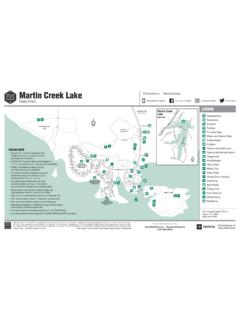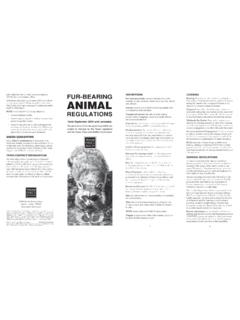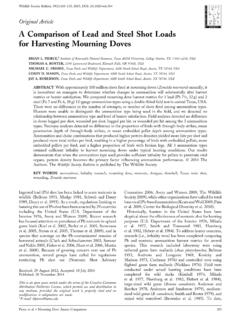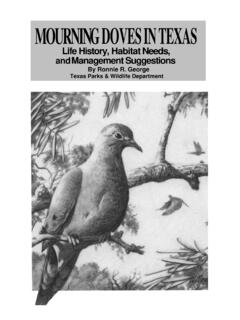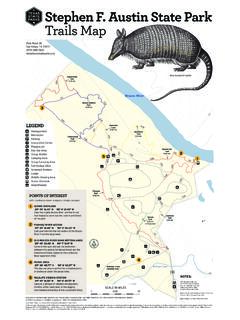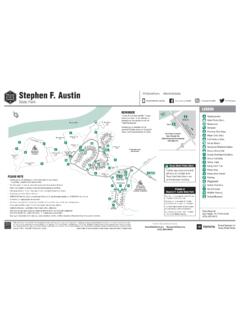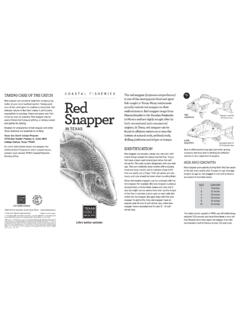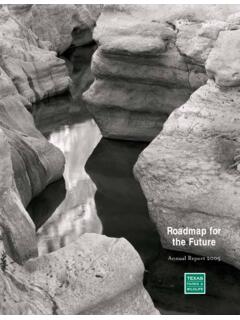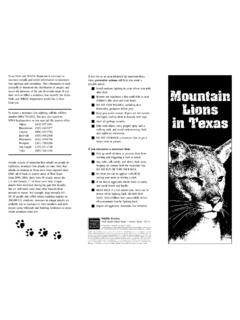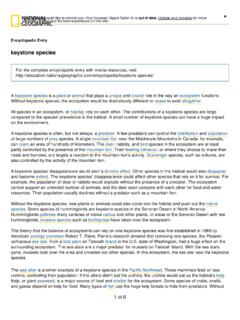Transcription of The Cats of Texas
1 CATS of TEXASW. B. DavisProfessor Emeritus, Texas A&M UniversityRevised by Texas Parks and Wildlife DepartmentAmong Texas brags is listed a first in the variety of kinds of wild catsthat roam her spacious primarily Central American cats (jaguar, jaguarundi, ocelot andmargay) currently or historically ranged northward into the brushlandsouth of San Antonio from Mexico. The jaguarundi and the margay occurin the United States only in this brushland; the other two are found alsoin Arizona. These four species are listed as endangered species in addition, Texas can claim as residents the mountain lion, whose rangeembraces most of North and South America, and the bobcat, which rangesfrom central Mexico northward into Canada.
2 In fact, there is only one nativewild cat living north of the Rio Grande and the Gulf of California whichis not found in Texas . It is that lover of cold climates the Canadian ocelot is the most beautiful Texascat. It is unique in that no two ocelot peltsare alike. Adult males may be as much as3feet, 10 inches long; females up to 3 is 20-35 pounds. Although theocelot s food habits have not been deter-mined completely, it has been reported thatbirds, including domestic poultry, arecaptured on their roosts. Rabbits, wood rats,mice of many kinds, as well as snakes andother reptiles, are also important items inthe ocelot s diet. Now restricted to severalisolated patches of suitable habitat in threeor four counties of the Rio Grande Plains,the ocelot once ranged over the entiresouthern part of the state, with occasionalrecords from north and central population in Texas is chief lythreatened by habitat loss resulting fromconversion of naturally-vegetated areas toagricultural land in South Texas and theRio Grande Valley.
3 Recent studies by Fish and Wildlife Service and TexasParks and Wildlife Department reveal thatthe ocelot is still found in scattered nativebrush areas of South Texas and some ofthese cats may now be using more [FER AL CAT]While the domestic cat has adapted itself in extraordinaryfashion to man s customs, it has not altogether lost its wild sleek, sleepy, and well-behaved by day, the cat, by night, maybecome a stealthy and serious the course of a bobwhite quail experiment in East Texas ,cats killed 8 quail and 10 cardinals in the experimental traps, onone occasion 6 quail at one also are known to catch and consume cotton rats and pocketgophers, and according to studies in Texas , cats consume Attwater sprairie-chickens, meadowlarks, chicken flesh and 1983, the Texas Legislature created the Nongame Fund.
4 This fundmay be used for nongame wildlife and endangered species researchand conservation, habitat acquisition and development, anddissemination of information pertaining to nongame for this fund is obtained through private donations and sale ofnongame wildlife art prints, decals and stamps. This fund now givesTexans a unique opportunity to help support this state s valuable andsensitive nongame resources. Your individual contributions andpurchases of nongame art prints, decals and stamps will helpdetermine the level of nongame conservation activities in more information call toll-free (1-800-792-1112) or contact:Wildlife Diversity Program, Texas Parks and WildlifeDepartment, 4200 Smith School Road, Austin, Texas Smith School RoadAustin, Texas 2000 Texas Parks and Wildlife Department.
5 PWD LF W7000 150 (3/00)In accordance with Texas Depository Law, this publication is available at theTexas State Publications Clearinghouse and/or Texas Depository Aid Projectfunded by your purchaseof hunting equipmentTEXAS PARKS AND WILDLIFEMARGAYS imilar to the ocelot in color and color pattern, but smaller and more slender, is the length is about three feet. Little is known of its breeding habits and food, but opossums areincluded in its is known from Texas only on the basis of one specimen taken at Eagle Pass byCol. S. Cooper over 100 years of this diminutive cat were found in Pleistocene deposits along the Sabine River inOrange County, indicating the Margay ranged over a considerable portion of South Texas a fewthousand years bobcat is a medium-sized, reddish brown cat about thesize of a chow dog.
6 Length of the adult is about 3 feet, 6 is 12 to 20 pounds, occasionally up to 36 pounds in old,fat males. Bobcats are highly adaptable felines and throughoutmost of their range in Texas have shown a marked ability tocope with the inroads of human bobcat s food consists mainly of small mammals andbirds. Among the mammals found in bobcat stomachs, woodrats, ground squirrels, mice and rabbits supply the bulk of thediet. Occasionally deer are killed and eaten, but most of thedeer meat found in bobcat stomachs has been carrion. Thebobcat also preys upon domestic sheep, goats and poultry. Thepredatory damage is not great, except in rare bobcat is the only native Texas cat which isimportant as a fur R [EL TIGRE]The jaguar is the largest and most robust ofthe spotted American cats.
7 Large males may growas long as seven feet and weigh up to 200 venturing into the high, cooler inlandareas, El tigre inhabits the dense chaparral andtimbered areas of the New World Tropics. Thiselegant cat shows a particular fondness for water-side habitats. It is extremely unlikely that this catoccurs in Texas although a rare visit by a wandererfrom Mexico is possible. Last verified Texas recordsdate from the turn of the century. The Jaguar isnow considered by most authorities to be extir-pated from the state. Its food habits are not wellknown. In Mexico, it is known to prey on peccariesand in the Amazon region it catches fruit-eatingfish using its sharp claws as gaff hooks, and itprobably preys on deer and large ground-dwellingbirds when such items are E.
8 W. Nelson reported that it is also fond ofsea turtle eggs. The Jaguar roams the beaches onspring nights, digs up the turtle eggs and enjoys adelectable IN LION [PUMA, COUGAR]The mountain lion is an unspotted cat. Malesmay be as much as 8 feet, 6 inches; females,6 feet, 71/2 inches. Weight of three malesaveraged 184 (160-227) pounds; sixfemales, 118 (105-133) mountain lion ranges over much ofthe Trans-Pecos of West Texas , the southerntwo-thirds of the Hill Country in CentralTexas, and a large portion of the South Texasbrushlands as well as in limited areas inNorth Central Texas . Within this range, the catis most common in remote, thinly populated ranchlandsbut may be encountered almost anywhere.
9 Changing land usepatterns have resulted in reduced predator control efforts in manylion-populated areas. As a consequence, lion populations currently appearto be holding their own or increasing in the southern, central, and westernportions of the and shy by nature, and largely nocturnal by habit, themountain lion is seldom seen in its native diet of the mountain lion consists almost entirely ofanimal matter; but, like the domestic cat, it occasionallyeats grasses and other vegetable matter. deer and javelinaare major food items; however, lions have been known totake elk and bighorn sheep as well as a variety of smaller to popular opinion, mountain lions rarely use caves as dens, preferring cliff crevices,overhanging ledges or enlarged badger burrows for a short breeding period of up to two weeks duration, they lead a solitary RUNDI [EYR A CAT]The jaguarundi is about twice the size of a domestic cat.
10 It has two color phases, one grayish, theother reddish. Length of males is about 3 feet, 6 inches, of which the tail is more than extremely rare in Texas , the sleek low-slung jaguarundi inhabits the brush country ofextreme southern Texas in Cameron, Hidalgo, Starr and Willacy counties. It reportedly eats rats, mice,birds and rabbits. Of all the cats, this one excels in ability to spring and jump, considering its size. Noinformation is available on home life, growth and development. Numerous sightings of this species arereported each year, but they are difficult to verify because of the similarity to wild house clearing of brushlands in the Rio Grande Valley threatens to destroy its habitat in to the ocelot in color and color pattern, but smaller and more slender, is the length is about three feet.
